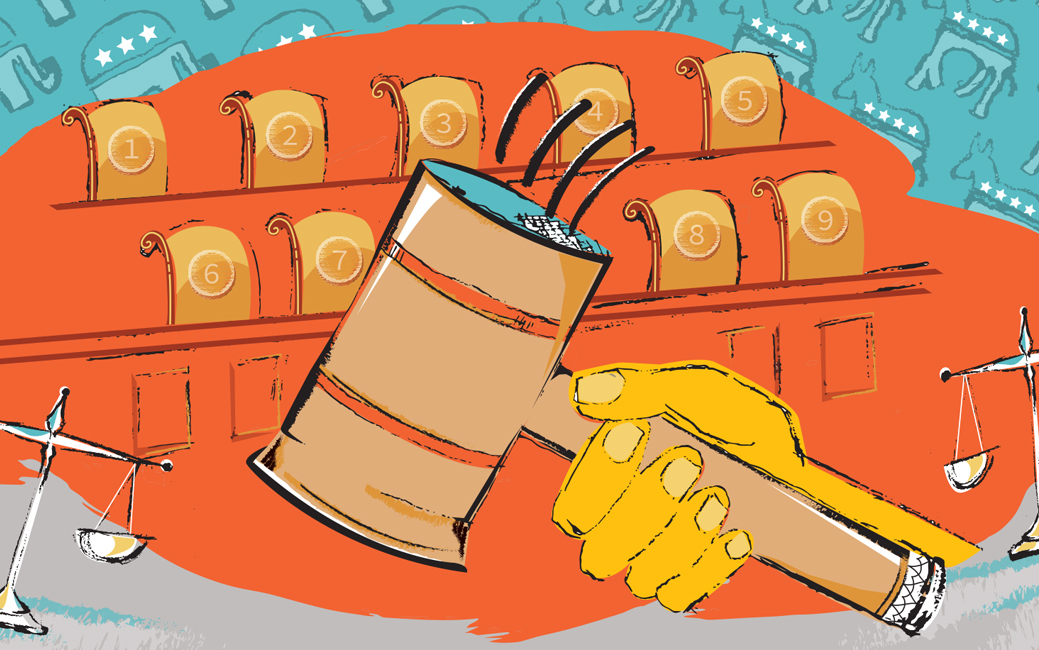Office Hours: Politics in the Judiciary
Jonathan Hensley, lecturer in the Department of Political Science, on the long and messy history of the Supreme Court.

The Constitution does not prescribe a particular number of judges for the Supreme
Court; Congress has the authority to set the size. The court’s membership has been
set as small as five in 1801 and as large as 10 in 1863, before settling on nine justices
in 1869.
When the Supreme Court was established, the first Congress created a six-member court,
and it didn’t take long for the membership to turn into a partisan issue. The Supreme
Court’s size changed six times over the last several hundred years.
When we speak of court packing—or court unpacking when you talk about decreasing the
size—we think of it as something that’s unusual and perhaps even illegitimate, but
it has happened before. Court packing is usually defined as adding seats to a court
in order to create a particular ideological majority on that court.
It started when John Adams lost the election of 1800 to Thomas Jefferson. After losing
that election, the lame duck Federalist Congress passed a judiciary act that created
new federal judgeships in the district courts. Adams also appointed John Marshall
as the chief justice before his term was out.
Marshall was a loyal Federalist, and Adams certainly knew that. And here you had for
the first time a change in party control in American government—the Federalist party
of Washington and Adams giving way to the Democratic-Republican party of Jefferson.
The Federalist Congress was attempting to lock in some Federalists in the judiciary,
partly by appointing Marshall but also by creating these new federal court judge positions
and appointing Federalist judges to those. Political conflict over the judiciary is
almost as old as the republic itself.
One of the most famous examples of court packing—that never actually happened—was
in February 1937 when Franklin Roosevelt was in his second term as president. He proposed
adding one new member for each justice over 70 years old or who had served for more
than 10 years. He was worried the court was going to keep overturning his New Deal
legislation. The plan never happened because a couple members of the Supreme Court
started changing their minds and upholding some of the legislation.
It’s worth pointing out that court packing doesn’t just happen with the Supreme Court.
There have been lots of attempts in the last 15 years or so in the state courts, which
existed before the Supreme Court, as well.
Among the concerns about the concept of court packing is that it can really affect
the ability of congressional majorities to make policy. This is a well-known issue
among scholars of the court, sometimes referred to as “the countermajoritarian difficulty,”
where you have an unelected court potentially overturning legislation passed by elected
majorities or interpreting it in certain ways that the majority did not want. And
that’s a problem that could persist a long time if you have justices appointed when
they are 50 years old. They could easily be on the court for 30 years.
Most of us who study the judicial branch believe that judges do have ideological leanings
that play a role in their decision-making, though they do not necessarily play the
most important role in every case.
But if you observe what the Supreme Court has done over the years, it’s hard not to
conclude that justices have ideological views that affect the way they rule on certain
cases. I think part of that should be attributed to the fact that the Supreme Court
hears complex cases, which lend themselves to good-faith differences in interpretation.
The Constitution is full of vague phrases, like “due process of law” and “equal protection
of the laws.” It is understandable that people will have different views that affect
how they understand what those words mean. But that could be a concern if the public
started to view the Supreme Court as being illegitimate and purely a partisan institution.
Current Chief Justice John Roberts has explicitly mentioned in some of his opinions
that the court should not be just a partisan institution. I think that’s something
that concerns some of the justices. I don’t know if it concerns all of them. It’s
fair to point out that there are always politics involved in the selection of Supreme
Court justices, and it’s not like court packing adds those politics where they aren’t
there. It’s just a more extreme political move, but the politics are always there.
